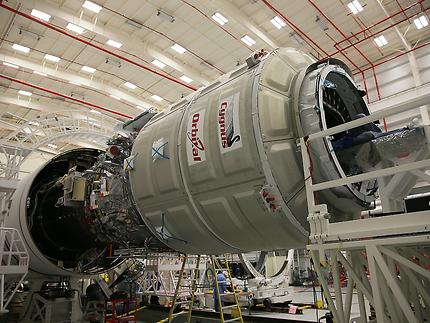
Orbital Sciences Corp. is ready to deliver its third Cygnus unpiloted cargo craft to the International Space Station (ISS), with liftoff of the ORB-3 mission scheduled to occur from Pad 0A at the Mid-Atlantic Regional Spaceport (MARS) on Wallops Island, Va., at 6:45 p.m. EDT Monday, 27 October. Coming 37 minutes after local sunset, this will be the first occasion on which Orbital’s two-stage Antares booster has launched in the hours of darkness. The launch has been subject to several days of delay, principally caused by the recent effects of Hurricane Gonzalo, and assuming an on-time liftoff on Monday evening Cygnus should complete its rendezvous and berthing at the ISS on the morning of Sunday, 2 November. It will spend about a month attached to the Earth-facing (or “nadir”) port of the station’s Harmony node and will deliver Orbital’s largest-ever load of equipment and supplies to the incumbent Expedition 41 crew, totaling 5,050 pounds (2,290 kg).
The ORB-3 mission is being executed under the language of Orbital’s $1.9 billion Commercial Resupply Services (CRS) contract, signed with NASA in December 2008, which requires the Dulles, Va.-based company to stage eight dedicated Cygnus flights by 2016 to deliver a total of 44,000 pounds (20,000 kg) of payloads and other items to the ISS. As part of the pre-requisites for this contract, Orbital conducted a Commercial Orbital Transportation Services (COTS) Demonstration Mission in September-October 2013 (known as “ORB-D”), ahead of its first “dedicated” flight (ORB-1) in January-February 2014. This was followed in July-August by the second (ORB-2) mission.
A growing tradition for each Cygnus flight has been to provide it with a name, honoring an individual who has contributed to the goals of Orbital itself or more broadly to the commercial space exploration agenda. ORB-D was named in tribute of veteran shuttle astronaut and senior Orbital executive G. David Low, whilst ORB-1 bore the name of former shuttle commander C. Gordon Fullerton and ORB-2 honored five-time space flyer Janice Voss. Continuing the tradition, the ORB-3 mission will pay homage to Deke Slayton, one of the “Original Seven” NASA astronauts, grounded from his Mercury flight by a heart murmur in 1962 and for many years a guiding light in the drive to plant human bootprints on the Moon, before eventually reaching space aboard the Apollo-Soyuz Test Project (ASTP) mission in July 1975. A full article about Slayton will be published by AmericaSpace on Monday, to coincide with the launch of his mechanical namesake.
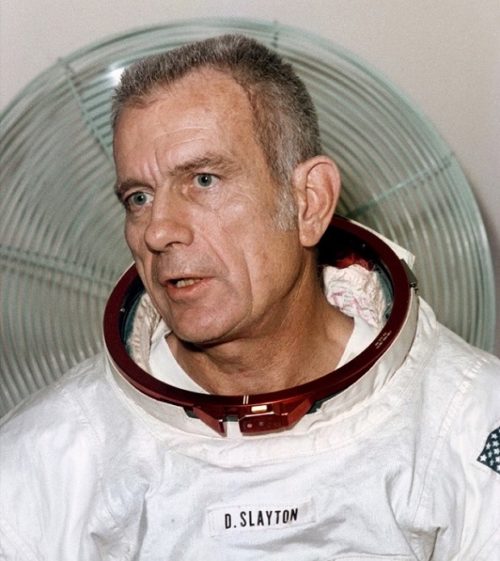
As dramatic as Slayton’s life was, the past 18 months have also been dramatic for Orbital Sciences, which first flight-tested its long-delayed Antares booster in April 2013 and went on to stage four rapid-fire Cygnus missions to the ISS. In launching ORB-3, Orbital will become the first CRS contract holder to achieve as many as three missions in a single calendar year, surpassing its partner, Hawthorne, Calif.-based SpaceX, whose Dragon cargo ship has to date staged two flights in 2012, one in 2013 and two to date in 2014. The next Dragon flight is presently scheduled for launch in December.
Five Antares launches in just over a year have provided an enormous shot in the arm for Orbital, since the 133-foot-tall (40.5-meter) booster represents its biggest home-grown launch vehicle and its first foray into large-scale cryogenic rocketry. Antares’ first stage is propelled by a pair of Aerojet-built AJ-26 engines—whose heritage extends back to the Soviet era, having originated as the NK-33 powerplants for the ill-fated N-1 lunar superbooster—and is fed by a combination of liquid oxygen and a refined form of rocket-grade kerosene, known as “RP-1.” Thirty-six of these engines were procured from Russia in the mid-1990s, at a reported cost of $1.1 million per unit, to which Orbital added modern electronics and made other performance enhancements. At the instant of liftoff, the two AJ-26 engines produce a total sea-level propulsive yield of 734,000 pounds (332,930 kg).
In spite of its subsequently impressive record, Antares underwent a tortured development process. The AJ-26 engines performed well on the test stand in 2010, although one of them caught fire in June 2011, following a kerosene leak, apparently induced by stress-corrosion cracks in the 40-year-old metal. Adding to these woes, Orbital’s new MARS launch site on Wallops Island, Va., was suffering its own headaches, including difficulties with new cryogenic tankage systems and the certification of propellant-loading operations. These problems conspired to delay the “A-ONE” maiden flight of the booster—which had by now gained the name “Antares” in place of the developmental name of “Taurus II”—from the spring of 2012 until April 2013.
When A-ONE finally launched, it delivered an instrumented “mass simulator” of Cygnus into an orbit of 155 x 186 miles (250 x 300 km), inclined 51.6 degrees to the equator, thereby providing a close analog for the opening minutes of a “real” ISS mission. That “real” mission came in September 2013, when Antares boosted the ORB-D Cygnus into orbit. The cargo ship was grappled by the Canadarm2 robotic arm a few days later and berthed at the nadir port of the Harmony node, where it spent three weeks, before being detached from the station and intentionally destroyed in the upper atmosphere. With the Demonstration Mission thus completed, Orbital pressed on with the dedicated ORB-1 and ORB-2 flights. The impressive success rate was tempered, however, by the May 2014 failure of an AJ-26 engine on the test stand at NASA’s Stennis Space Center in Hancock County, Miss. The subsequent investigation caused ORB-2 to be delayed by several weeks, although efforts are now back on track for ORB-3 and two more Cygnus missions—ORB-4 in April and ORB-5 in September —are currently manifested in 2015.
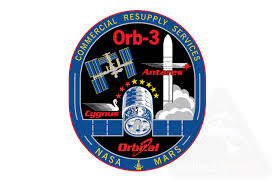
Orbital initially scheduled the ORB-3 launch to occur last week, although the effects of Hurricane Gonzalo rendered such plans untenable. The hugely destructive Gonzalo, which has thus far caused in excess of $200 million of damage, formed from a tropical wave in the Caribbean on 12 October and grew in strength and ferocity as it passed through the Leeward Islands. Intensifying into a Category 4 major hurricane—the first in the Atlantic since Ophelia, three years ago—Gonzalo peaked on 16 October with sustained winds as high as 145 mph (230 km/h). It then steadily weakened, reaching Category 2 strength when it reached central Bermuda on the 18th, although it still retained sufficient punch to down trees and power lines and wreak extensive damage to homes. During its destructive rampage, the hurricane also destroyed houses in Antigua and Barbuda, as well as boats on the island of Saint Martin, before its remnants headed on 20 October toward a landfall in the United Kingdom, where heavy rain and gale-force winds battered the west coast.
“The Wallops Range relies on the Bermuda downrange assets to track and maintain data communications with the Antares rocket during flight and ultimately to ensure public safety during launch operations,” explained Steven Kremer, head of the Wallops Range and Mission Management Office. After Gonzalo had passed Bermuda, a team from NASA’s Wallops Flight Facility Range returned to the tracking site to assess the situation and steps were taken to re-enable its functionality in support of the ORB-3 launch, which was by now rescheduled for 27 October. “However, depending on the impact of the storm on Bermuda’s essential infrastructure systems, such as transportation, power and communications,” it was cautioned, “the launch date could be moved later. The launch schedule has been established in order to build flexibility into the overall mission schedule.”
In the meantime, the ORB-3 Cygnus spacecraft arrived at Wallops Island in mid-June for pre-launch processing. This included tests of its Passive Common Berthing Mechanism (CBM), which is its primary interface with the space station, and a Final Integrated Systems Test (FIST) was completed in early July. The spacecraft was transported on 16 October from the NASA fueling facility on Wallops Island to the Horizontal Integration Facility (HIF) to be mated with Antares. The elements of the booster itself had been arriving, piecemeal, at Wallops, throughout the year: The first stage came in February and was ensconced in the HIF, followed by the Castor-XL second stage engine hardware in mid-May, the twin AJ-26 first-stage engines in March and July, and the payload fairing over the summer.
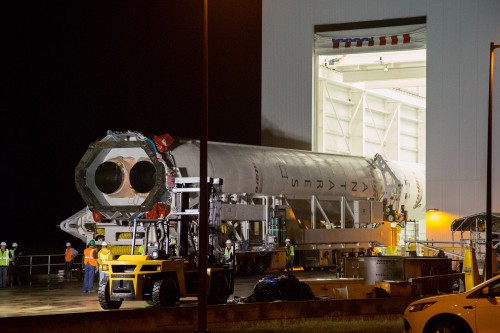
On Thursday, 23 October, the final, time-critical “late-load” cargo items were loaded aboard Cygnus’ Pressurized Cargo Module (PCM), ahead of the installation of Antares’ bullet-like payload fairing. Cygnus is a two-piece spacecraft, whose PCM is built by Thales Alenia Space and based in design upon the Multi-Purpose Logistics Modules (MPLMs), used for cargo deliveries on 12 shuttle flights between March 2001 and July 2011. Attached to the PCM is Orbital Sciences’ home-built Service Module (SM).
Following integration with the booster, the complete stack undertook the approximately one-mile (1.6-km) rollout to Pad 0A on Friday, 24 October. Antares was transferred to the pad in a horizontal orientation, then raised to the vertical, by means of the Transporter-Erector-Launcher (TEL). Assuming that no weather or technical issues impair Monday evening’s launch attempt, the Antares/Cygnus flight control team will receive their “Call to Stations” at about 3 p.m. EST, a little under four hours before T-0. About 45 minutes later, the process of “chilling down” the fuel lines of the rocket’s first stage with liquid nitrogen will get underway, prior to the loading of cryogenic propellants. This chill-down protocol serves to avoid catastrophically shocking the hardware by being suddenly hit by a rapid temperature differential. After polling the launch team at T-90 minutes, propellants will begin flowing. This process is critically timed to begin 90 minutes ahead of launch, due to temporal limits associated with the rapid boil-off of the cryogenics. A final poll will occur in two stages and the fueling operation will end at T-15 minutes. By this point, all propellants will be at “Flight Ready” levels and a firm “Go for Launch” will be declared.
Antares will transition to internal power and at T-11 minutes the TEL will be armed to execute a rapid retraction from the booster at the instant of liftoff. At T-5 minutes, the Flight Termination System (FTS)—which will destroy the vehicle in the event of a major accident during ascent—will itself be armed and placed onto internal power. Next, with three minutes and 30 seconds remaining on the clock, the “Terminal Count” will commence. At this stage, Antares’ autosequencer will assume primary command of all critical functions, controlling all events up to the ignition of the twin AJ-26 engines at T-0. Under careful computer control, the engines will steadily ramp up to full power for two seconds, producing a launch at 6:45 p.m. EST Monday.
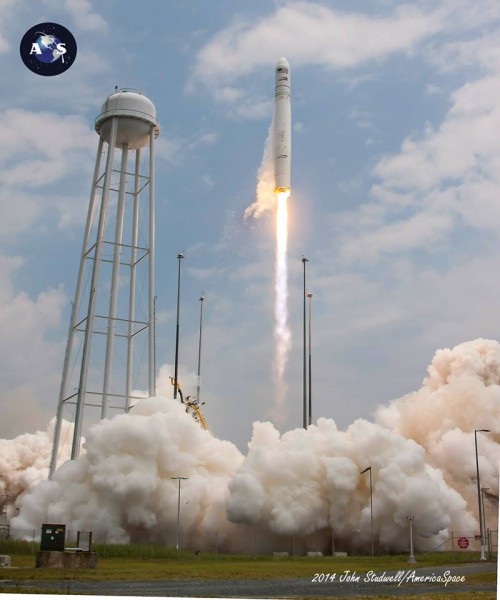
Monday’s sunset on Wallops Island is expected at 6:08 p.m., and “last light” is anticipated at 6:35 p.m., which means that ORB-3 will be the first Antares mission to launch in the hours of darkness. Seconds after clearing the Pad 0A tower, the rocket will perform a combined pitch and roll program maneuver to establish itself on the correct flight azimuth to inject Cygnus into low-Earth orbit. Maximum aerodynamic turbulence (colloquially known as “Max Q”) will be experienced through the airframe at T+80 seconds and the AJ-26 engines will continue to burn hot and hard, until they are shut down at T+4 minutes and 15 seconds. By this point, the booster will have attained an altitude of 70 miles (112 km) and a few seconds afterwards the first stage will be jettisoned.
Next will come the turn of the second stage. On previous Antares launches, this stage was powered by a single Castor-30 solid-fueled engine, fabricated by Alliant TechSystems, but ORB-3 will represent the first flight of the new Castor-XL. Unlike the Castor-30, which measured 11.5 feet (3.5 meters) long and 7.5 feet (2.3 meters) in diameter and weighed 30,000 pounds (14,000 kg), the “stretched” Castor-XL measures 19.7 feet (6 meters) long and 7.5 feet (2.3 meters) in diameter and weighs 56,000 pounds (25,000 kg). Its nozzle alone measures 8 feet (2.4 meters) long, with a “submerged” design, high-performance expansion ratio of 56:1, and a dual-density exit cone. The Castor-XL will henceforth be employed to power the final six dedicated Cygnus missions—from ORB-3 through ORB-8—and enable the transition toward launching additional cargo, by means of the “Enhanced Cygnus,” which will debut with ORB-4 in April 2015.
Following the separation of Antares’ first stage, the vehicle will coast briefly, ahead of discarding the bulbous, 32.5-foot-tall (9.9-meter) payload shroud at about T+5 minutes and 30 seconds. Ignition of the Castor-XL will occur about six minutes into the flight, burning for around 140 seconds and providing Cygnus will its final push into low-Earth orbit at a mean altitude of about 125 miles (200 km), inclined 51.6 degrees to the equator.
Ten minutes after leaving Wallops Island, the fifth Cygnus in history should be successfully inserted into orbit. ORB-3 also represents the last “Standard” Cygnus to fly, with all future missions expected to be of the “Enhanced” variant of the craft. This will benefit from a larger Pressurized Cargo Module (PCM)—with an interior volume of 950 cubic feet (27 cubic meters), as opposed to 635 cubic feet (18 cubic meters)—together with upgraded electricity-generating solar arrays and the capacity to transport an additional 1,500 pounds (700 kg) of payload to the ISS.
Under normal circumstances, a rendezvous profile of three to four days should bring the cargo ship into close proximity with the ISS, for capture and berthing via the 57.7-foot-long (17.6-meter) Canadarm2. However, ORB-3 is not expected to conclude its rendezvous for more than five days, with the spacecraft’s capture by Expedition 41 crewmen Reid Wiseman, Alexander Gerst, and Barry “Butch” Wilmore anticipated early Sunday, 2 November. “Taking advantage of Cygnus’ operational capabilities,” it was explained, “Orbital is launching the ORB-3 mission several days earlier than necessary to preserve schedule flexibility and time its arrival at the station to conform to other Visiting Vehicle operations.”
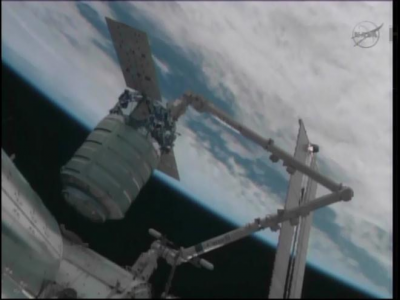
Shortly after insertion into orbit, Cygnus’ twin gallium arsenide solar arrays will be unfurled, generating a total of 3.5 kilowatts of electrical capability, and the spacecraft will be commanded to perform a series of “phasing” maneuvers to bring it closer to the ISS. Its rendezvous “toolkit” includes the Triangulation LIDAR (or “TriDAR”), a model-based laser navigation sensor, which will compare its readings with a Computer Aided Design (CAD) model of the ISS to determine relative positions and attitudes. The spacecraft will also feature a lightweight Quasonix S-band radio for telemetry and command capability.
By the early hours of Sunday morning, Cygnus—or “Spaceship Deke Slayton,” as it will be labeled—will hold position at a distance of 39.4 feet (12 meters) from the space station. At this stage, Wiseman, Gerst, and Wilmore will operate controls from inside the multi-windowed cupola to grapple Cygnus, via Canadarm2, at about 4:58 a.m. EST. A little under two hours later, they will berth the spacecraft at the Harmony nadir interface and open the hatches to begin unloading its cargo. Carrying an estimated 5,050 pounds (2,290 kg) of supplies, ORB-3 is by far the heaviest Cygnus to date, offering an express delivery bonanza above the 1,540 pounds (700 kg) delivered by ORB-D in September 2013, the 2,780 pounds (1,260 kg) delivered by ORB-1 in January 2014, and the 3,290 pounds (1,490 kg) delivered by ORB-2 in July 2014.
One key payload aboard ORB-3 is Arkyd-3, a CubeSat technology demonstrator, provided by Redmond, Wash.-based Planetary Resources, Inc., which seeks to develop and implement asteroid mining technologies. As part of its initial business plan, the company seeks to construct a series of small space telescopes, each weighing 65-110 pounds (30-50 kg), for Earth observation and astronomical research. Arkyd-3—the name pays homage to Planetary Resources, Inc.’s original company name, prior to its spring 2012 reorganization—takes the form of a “3U” CubeSat, measuring 11.8 x 3.9 x 3.9 inches (30 x 10 x 10 cm), and will serve as a pathfinding test satellite. It will be followed in late 2015 by Arkyd-100, which will be equipped with an optical telescope. Planetary Resources, Inc., contracted with NanoRacks to transport Arkyd-3 to the ISS, where it will be released into space through the airlock in Japan’s Kibo laboratory module. Arkyd-3 will test avionics, attitude-determination hardware, control systems, and an integrated propulsion system.
The forward plans for the company are ambitious. Arkyd-100 is described as an “Earth-observer and asteroid-locator,” providing on-demand imaging to consumers, scouting for “potentially viable” asteroids from its position in low-Earth orbit. Subsequent spacecraft include the Arkyd-200, which will intercept asteroids and gather data on their physical characteristics, whilst the more advanced Arkyd-300 is tasked with deep-space exploration of celestial targets in the inner Solar System.
The ORB-3 Cygnus will remain attached to the ISS for about four weeks, before being robotically detached, again via Canadarm2, on 3 December, and discarded in the upper atmosphere. At the conclusion of the mission, Orbital Sciences will have delivered a total of 13,378 pounds (6,078 kg) of essential supplies, equipment, and experiments to the space station and will have removed 13,444 pounds (6,097 kg) of disposable items.
Want to keep up-to-date with all things space? Be sure to “Like” AmericaSpace on Facebook and follow us on Twitter: @AmericaSpace




Wallops is a great place to see a launch. I could not believe how close you can get to the launch pad to view a lift-off. The last flight we were 1.5 miles from the pad, much closer than other rockets allow. Very loud and impressive being that close.